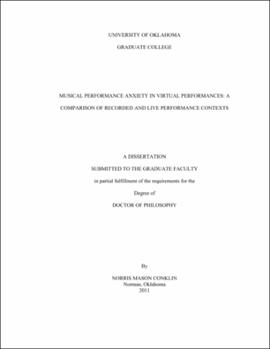| dc.contributor.advisor | Magrath, Jane | |
| dc.creator | Conklin, Norris Mason | |
| dc.date.accessioned | 2019-04-27T21:33:45Z | |
| dc.date.available | 2019-04-27T21:33:45Z | |
| dc.date.issued | 2011 | |
| dc.identifier | 99299071902042 | |
| dc.identifier.uri | https://hdl.handle.net/11244/319014 | |
| dc.description.abstract | The purpose of this research was to compare the level and experience of Musical Performance Anxiety (MPA) in university level piano students performing in a traditional live performance context and a proposed virtual performance context. A virtual performance is a musical performance that is recorded and distributed to an audience not present at the time of the recording. Additionally, the research investigates exposure therapy in the virtual performance context and the possible transfer of benefits into subsequent live performances. | |
| dc.description.abstract | The eleven (11) participants of this instrumental case study performed in three performance contexts: a rehearsal performance with no audience that was not recorded, live performances in front of an audience, and virtual performances that were recorded and distributed to an internet audience via podcast. For each performance, the participants completed the Conklin Performance Anxiety Inventory (CPAI) to measure the severity of MPA experienced. After the Rehearsal Performance, Live Performance 1, and Virtual Performance, the subjects sat for an extensive interview comparing the manifestation of MPA in each performance context. The research population then recorded five additional virtual performances, constituting the exposure therapy. After exposure therapy, the participants played in a Live Performance 2, sat for another interview, and convened for a group discussion. | |
| dc.description.abstract | Statistical analysis of the CPAI scores reported for each performance and qualitative analysis of the individual interviews and group discussions show that the virtual performance context elicited significantly lower levels of MPA than the live performance context. The participants experienced almost no physiological symptoms of MPA and fewer mental symptoms in the virtual performance. Interestingly, the first interview in which the participants identified individual symptoms of MPA proved a significant event. As they became more aware of the individual symptoms, they began to identify certain symptoms that could be overtly addressed and were also more accepting of those symptoms not under volitional control. | |
| dc.description.abstract | Exposure therapy indicated some success in reducing levels of MPA in the later Exposure Performances and in Live Performance 2. Qualitative analysis revealed that the improvement was the result of the subjects having more confidence in their level of preparation, either as a result of demonstrated success or by correcting weaknesses revealed in the virtual performance context. | |
| dc.description.abstract | Additionally, the Kenny Music Performance Anxiety Inventory (K-MPAI) used to categorize the population as those prone to experiencing high, moderate, or low levels of MPA showed a significant positive correlation with the CPAI scores from the Live Performance 2. Further validation efforts for the K-MPAI could provide a meaningful diagnostic instrument to identify individuals needing more focused and thorough intervention. | |
| dc.format.extent | 861 pages | |
| dc.format.medium | application.pdf | |
| dc.language | en_US | |
| dc.relation.requires | Adobe Acrobat Reader | |
| dc.subject | Performance anxiety | |
| dc.subject | Music--Performance--Psychological aspects | |
| dc.subject | Anxiety | |
| dc.title | Musical Performance Anxiety in virtual performances: A comparison of recorded and live performance contexts | |
| dc.type | text | |
| dc.type | document | |
| dc.thesis.degree | Ph.D. | |
| ou.group | Weitzenhoffer Family College of Fine Arts::School of Music | |
